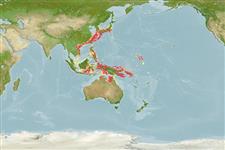>
Eupercaria/misc (Various families in series Eupercaria) >
Labridae (Wrasses)
Etymology: dewapyle: Name coming from the combination of the surnames of Mr Shin-ichi Dewa and Dr Richard L. Pyle, collectors of all type specimens; noun in apposition.
Eponymy: The binomial combines the surnames of the collectors of the type specimens: Shin-ichi Dewa (q.v.) and Richard L Pyle (q.v.) (Ref. 128868), visit book page.
Environment: milieu / climate zone / djupintervall / distribution range
Ekologi
marina pelagic-neritic; djupintervall 65 - 99 m (Ref. 105428), usually 65 - 70 m (Ref. 105428). Tropical; 20°C - 24°C
Utbredning
Länder | FAO områden | Ekosystem | Förekomster | Prickkarta | Utplanteringar | Faunafri
Western Pacific Ocean: from southern Japan (Iou-jima), Papua New Guinea and Fiji; including Indonesia.
Size / Vikt / Age
Könsmognad: Lm ? range ? - ? cm
Max length : 5.6 cm SL hane/ej könsbestämd; (Ref. 105428)
Short description
Bestämningsnycklar | Morfologi | Morfometri
Taggstrålar i ryggfenan (totalt) : 10; Mjukstrålar i ryggfenan (totalt) : 11; Taggstrålar i analfenan: 3; Mjukstrålar i analfenan: 12. This species is distinguished by the following set of characters: scale rows in longitudinal series 41-42 (mode 41); pored lateral-line scales 39-40 (39); gill rakers 12-13 (13); least distance between anteroventral margin of orbit and maxilla 1.2-3.7% (mean 2.5%) of SL; without red blotches superimposed and protruded on midlateral red stripe in adults and young; without yellow stripe on dorsal fin; the space between upper and midlateral red stripes vivid yellow; in young individuals, black blotch superimposed on midlateral red stripe on opercle, blotch fading with growth (Ref. 105428).
Body shape (shape guide): elongated; Cross section: oval.
An epibenthic species found on sandy, rubble and coral bottoms, with individual males sometimes
accompanied by a small harem (pers. comm. K. Nishiyama). It is most commonly seen at depths of 65-70 m during cold upwelling events (temperatures of 20-24C°) with adults observed to dive into the burrows of other organisms when startled, at Menjangan and Nusa Penida islands off Bali, Indonesia (Ref. 105428).
Life cycle and mating behavior
Könsmognad | Reproduktion | Lek | Ägg | Fecundity | Larver
Fukui, Y. and H. Motomura, 2015. A new species of deepwater wrasse (Labridae: Terelabrus) from the western Pacific Ocean. Zootaxa 4040(5):559-568. (Ref. 105428)
IUCN Red List Status (Ref. 130435: Version 2025-1)
Threat to humans
Harmless
Human uses
Verktyg
Special reports
Download XML
Internet-källor
Estimates based on models
Phylogenetic diversity index (Ref.
82804): PD
50 = 0.6250 [Uniqueness, from 0.5 = low to 2.0 = high].
Bayesian length-weight: a=0.00490 (0.00204 - 0.01176), b=3.15 (2.94 - 3.36), in cm total length, based on LWR estimates for this (Sub)family-body shape (Ref.
93245).
Trofisk nivå (Ref.
69278): 3.3 ±0.4 se; based on size and trophs of closest relatives
Resiliens (Ref.
120179): Hög, lägsta populationsfördubblingstid mindre än 15 månader (Preliminary K or Fecundity.).
Fishing Vulnerability (Ref.
59153): Low vulnerability (10 of 100).
🛈
